Handling Uncertainty in Human Cognitive Reliability Method for Safety Assessment Based on DSET
Yujun Su,Xianghao Gao,Hong Qian and Xiaoyan Su,★
1State Key Laboratory of Nuclear Power Safety Monitoring Technology and Equipment,Shenzhen,518172,China
2School of Automation Engineering,Shanghai University of Electric Power,Shanghai,200090,China
ABSTRACT Human Reliability Analysis(HRA)is an important part in safety assessment of a large complex system.Human Cognitive Reliability(HCR)model is a method of evaluating the probability that operators fail to complete during diagnostic decision making within a limited time,which is widely used in HRA.In the application of this method,cognitive patterns of humans are required to be considered and classified,and this process often relies on the evaluation opinions of experts which is highly subjective and uncertain.How to effectively express and process this uncertain and subjective information plays a critical role in improving the accuracy and applicability of HCR.In this paper,a new model was proposed to deal with the uncertain information which exists in the processes of cognitive pattern classification in HCR.First,an evaluation panel was constructed based on expert opinions and processing including setting corresponding anchor points and qualitative indicators of different cognitive patterns,and mapping them to fuzzy numbers and unit intervals.Second,based on the evaluation panel,different analysts judge the cognitive pattern types of actual specific events and provide the level of confidence he or she has in the judgments.Finally,the evaluation opinions of multiple analysts were expressed and fused based on the Dempster-Shafer Evidence Theory(DSET),and the fused results were applied to the HCR model to obtain the Human Error Probability(HEP).A case study was used to demonstrate the procedure and effectiveness of the proposed method.
KEYWORDS Safety assessment;human reliability analysis;human cognitive reliability;human error probability;Dempster-Shafer evidence theory
1 Introduction
Safety assessment of large complex systems like nuclear power plant,air transportation system,gas system,etc.,is important and should be carried out before and during their operations[1-5].With the development of mechanical science,material science and software system [6-10],the reliability of system and equipment has been notably improved.Human error has become the main factor that influences the safety of human-machine system in large complex systems.Considering the serious consequences of human error,HRA has received great concern and has been widely used in nuclear power plant operation [11,12],transportation [13,14],public health[15-17] and other fields.HRA is defined as the probability that a person can correctly complete the task specified by the system function within the specified time without additional behavior that degrades the system function.Its purpose is to analyze and predict the contribution of humans to the system reliability,reduce and prevent errors caused by humans and ensure the security and reliability of system operation.
Among multitudinous developed HRA methods,HCR is favored by many scholars because of its advantages in effectiveness,availability,reliability and engineering [18-20].Based on cognitive psychology,the HCR model emphasises the study of the influence of human psychology on operational performance,exploring the mechanism of human error,and quantitatively analyzing the reliability of human behavior using computational models.This method adopts the SRK three-level behavior model as a cognitive model framework,human cognitive behavior can be divided into Skill-based(S),Rule-based(R),Knowledge-based(K)[21].Skill-based behavior refers to the instinctive response of the operator to the familiar stimulus.Rule-based behavior means that the operator must perform some actions step by step according to the procedure.Knowledge-based behavior means the situation is unfamiliar,even has never been encountered,the operator must make decisions depending on experience and knowledge [21].Furthermore,in this method,the non-response probability that the operator does not respond to during the accident symptom within the specified task time follows a three-parameter Weibull distribution in which the parameters depend on the type of cognitive behavior.However,there is subjectivity and uncertainty in the classification process because the specific classification mainly depends on the experts evaluation opinion.Moreover,the boundary between the three cognitive patterns is intangible,therefore,the traditional HCR cannot reasonably express and deal with the uncertain opinions of experts,which limits the application of HCR in practice.
Various methods were established to handle uncertain information [22-26].Compared with the traditional probability theory,DSET [27,28] introduces the power sets of the propositions of interest,and assigns basic belief to those power sets [29].DSET can not only express random uncertainty effectively,but also express incomplete information and subjective uncertain information.Several approaches were investigated to measure the ability of DSET in handling uncertain information [30-33].Because of its powerful ability of to process uncertain information,DSET has been a major concern to researchers in the fields of safety assessment,reliability analysis,decision making,pattern classification [34-37].This paper proposes a new method based on D-S evidence theory to deal with uncertainty in HCR method,aiming to express more effectively the uncertainty in cognitive pattern classification process and reduce subjectivity.
This paper is organized as follows:In Section 2,basic concepts of classical HCR and DSET are introduced.In Section 3,the detailed process of improved HCR model is introduced.In Section 4,a case study proves the effectiveness of the improved HCR model.Section 5 concludes the paper.
2 Basic Theory
2.1 Overview of HCR Method[38]
HCR method is mainly used to deal with human reliability in the process of operator diagnosis after accident.The main purpose of HCR is to quantify the cognitive diagnosis process of operators that is closely related to time,obtain the non-response probability of operators in association with task performance within a specific time,and to describe their relationship with normalized time by using different non-response probability curves for three different behavioral conditions.
2.1.1 Behavior Patterns of HCR Model
In the HCR model,types of human behavior in the system are divided into three categories according to the characteristics of task execution.The model of three-level behavior(SRK)of human is described as follows.
1)Skill-based:Skill-based behaviors are unconscious and do not depend on the complexity of the task.This type of mistake is mainly caused by negligence and do not require decision-making process,and operators respond immediately after stress.
2)Rule-based:Rule-based behaviors refer to those human behaviors that are controlled and dominated by a group of procedures or protocols,and operators deal with this information after stress and select the correct procedures or protocols for implementation.
3)Knowledge-based:Knowkedge-based refers to when a new situation is encountered and there is no readily available procedure,the operator has to rely on their own knowledge and experience to diagnose and deal with it.
2.1.2 Basic HCR Process
The basic flow chart of HCR model is shown in Fig.1.
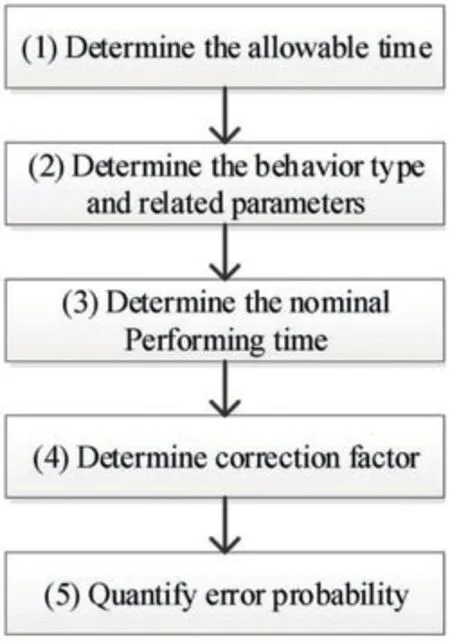
Figure 1:Flow chart of HCR
Step 1:Determine the allowable time TA.Before the use of the HCR model in quantifying human behavior,it was assumed that the behavior was time-related.If the correct response timeTused by an operator was greater than the allowable timeTA,the operator’s non-response error event will occur.The correct response time is the time that the operator takes from fault recognition to correct the response.
Step 2:Determine the behavior pattern and related parameters.Relevant parameters of HCR were obtained from experiments,and the parameters were different for different experimental subjects.Experimental data of the International Atomic Energy Agency(IAEA)were adopted in this paper,which is shown in Table 1.

Table 1:Parameter values [39]
Step 3:Determine the nominal performing time T1/2,nominal.In the HCR model,the nominal performing time(or normalized time condition)is defined as the operator’s median response timeT1/2,nominalto an incident scenario.
Step 4:Determine correction factor.The HCR method also considers the influence of the operator performance shaping factor(PSF)on the performing time.The nominal performing timeT1/2,nominalis corrected as performing timeT1/2through PSFs such as operator experience(K1),stress level(K2),human-machine interface(K3)and so on,and then the error probability is adjusted.The correction factors were obtained from a previous research experimental data [39].Take operator experience(K1)for example,if the operator is an expert or well trained,K1=-0.15 and if the operator is a novice,K1=0.4.Thus,the corrected median performing time is shown as follows:

Step 5:Quantify error probability.A three-parameter Weibull distribution(see Eq.(2))was selected to quantify the operator’s non-response probability

where,T1/2is the corrected median performing time to complete a certain diagnosis decision and response.Cri,Cηi,βiare the parameters of weibull distribution related to three different behavior patterns,which are concluded from experimental data.tis the time for operators to complete a certain task.P(t)is the non-response probability of the operator at the moment oft,forming the set of all propositions.
2.2 Dempster-Shafer Evidence Theory[27,28]
Definition 2.1(Frame of Discernment).In this theory,the questions to be decided are formed into a set,which is called the frame of discernment,denoted asΘ={θ1,θ2,...,θN},where,these elements are finite non-empty sets and mutually exclusive.In this case,the number of elements inΘ’s power setP(Θ)that contains all the set of propositions is 2N.TheP(Θ)is shown as follows:

where,proposition A is an element ofP(Θ).

Definition 2.2(Basic Belief Assignment,BBA).If the mapping from the power setP(Θ)to the unit interval(i.e.,m:P(Θ)→[0,1])matches all of the following:thenmis defined as the BBA function onΘ,also known as the mass function or evidence.The massm(A)indicates the degree of evidence supporting the proposition.Them(Θ)represents uncertainty of evidence.
Definition 2.3Assume thatmis a BBA onΘ,αis the value of the unit interval,ifα⊗m:P(Θ)→[0,1] satisfies:

thenα⊗mis called the discount operation onBBA m,αis the discount coefficient,andBBAafter the discount process is denoted asαm.αis used to represent the credibility of evidence source and revise the reliability of evidence.
Definition 2.4[Dempster’s rule of combination] The classic Dempster combination rule is used to integrate the effects of multiple BBAs,its essence is the orthogonal sum of evidence.
Assume thatXandYare bodies of evidence and the new evidenceCafter fusion ofXandYcan be calculated as follows:

where K is called conflict coefficient.
Definition 2.5(Pignistic probability function).Letmbe a BBA ofΘ.Its corresponding pignistic probability functionBetPm:Θ-→[0,1] is defined as

where |A|is the cardinality of subset A.
3 Improved HCR Model
The overall flow chart of the improved HCR model is shown in Fig.2.The main contribution of the new method is reflected in the process of Step 2,and the other steps are basically consistent with the classical HCR method.In classical HCR,the type of behavior is given directly by the experts and each behavior corresponds to only one type.Different from classical HCR,this method does not directly determine the type of behavior.The proportion of each type of behavior(probability distribution)was obtained by integrating the evaluation opinions of multiple experts through uncertainty processing,based on D-S evidence theory.The flow method of the improved Step 2 is described below,and the detailed Steps are as follows.

Figure 2:Flow chart of the improved HCR model
Step 2.1:Construct the judging panel.This step requires related field experts to build a fuzzy judgment panel(see Fig.3)based on their knowledge and experience,which should contain fuzzy membership function,anchor points and linguistic judgment,so as to guide analysts to make judgments.Since the Rule-based behavior contains most operational behaviors,the membership function corresponding to the Rule-based(R)takes up the largest proportion in the panel.In addition,as there is no obvious and clear boundary between S,R and K,fuzzy numbers are used in this paper for expression,and the ordinate of the intersection point of membership function between fuzzy numbers is 0.5 to facilitate further calculations.
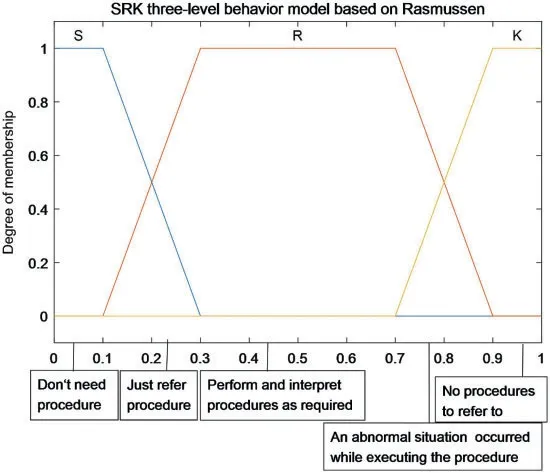
Figure 3:Fuzzy judgment panel
Step 2.2:The analyst makes judgment and gives confidence.In order to fully express fuzzy and uncertain information,the input contents of the analyst was divided into two parts:One is to provide classified evaluation information on the panel.The input can be either a point or an interval,and a point can be regarded as a special form of an interval as shown in Fig.4.The second is the analyst’s confidence in his evaluation opinion.Confidence degree was used to express the analyst’s confidence in his judgment,ranging from 0 to 1,where 0 means no confidence in his judgment at all and 1 means full confidence [40].
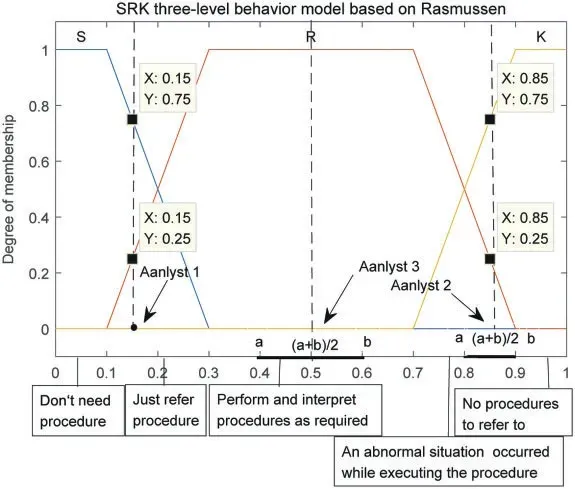
Figure 4:Different judgments of analysts
Fig.4 and Table 2 show the judgment inputs of different analysts under different circumstances,including evaluations of three behavior types(judgment intervals)as shown in Fig.4 and confidence in their judgments.Analyst 1 believes that a certain behavior classification depends on the operator’s familiarity with the rules,thus,its judgment is determined at point 0.15,that is,the behavior is between the Rule-based and the Skill-based(S-R)and tends to the Skill-based.In addition,the analyst has the confidence level of 0.6.Analyst 2 suggested that a certain behavior may have abnormal conditions beyond the procedures,which means the behavior is between the Rule-based and the Knowledge-based(S-K),and is more likely to be Knowledge-based.However,the analyst is uncertain about this judgment and cannot locate it to a precise point.Therefore,the judgment interval [0.8,0.9] is given.The confidence level of judgment is 0.8 since the analyst has very high confidence in this judgement.The judgment of Analyst 3 is interval [0.4,0.6],believing that the behavior belongs to the Rule-based behavior,but he is not sure whether the procedure needs to be explained,and his confidence degree is 0.9.

Table 2:Different analysts’judgments and confidence
Step 2.3:The BBA is constructed from the judgment of different analysts.In this step,a new BBA generation method was proposed.Assume that the frame of discernment isΘ={θ1,θ2,θ3},whereθi(i=1,2,3)represent S,R,K,respectively.The BBAs of different analysts can be constructed by following formula:
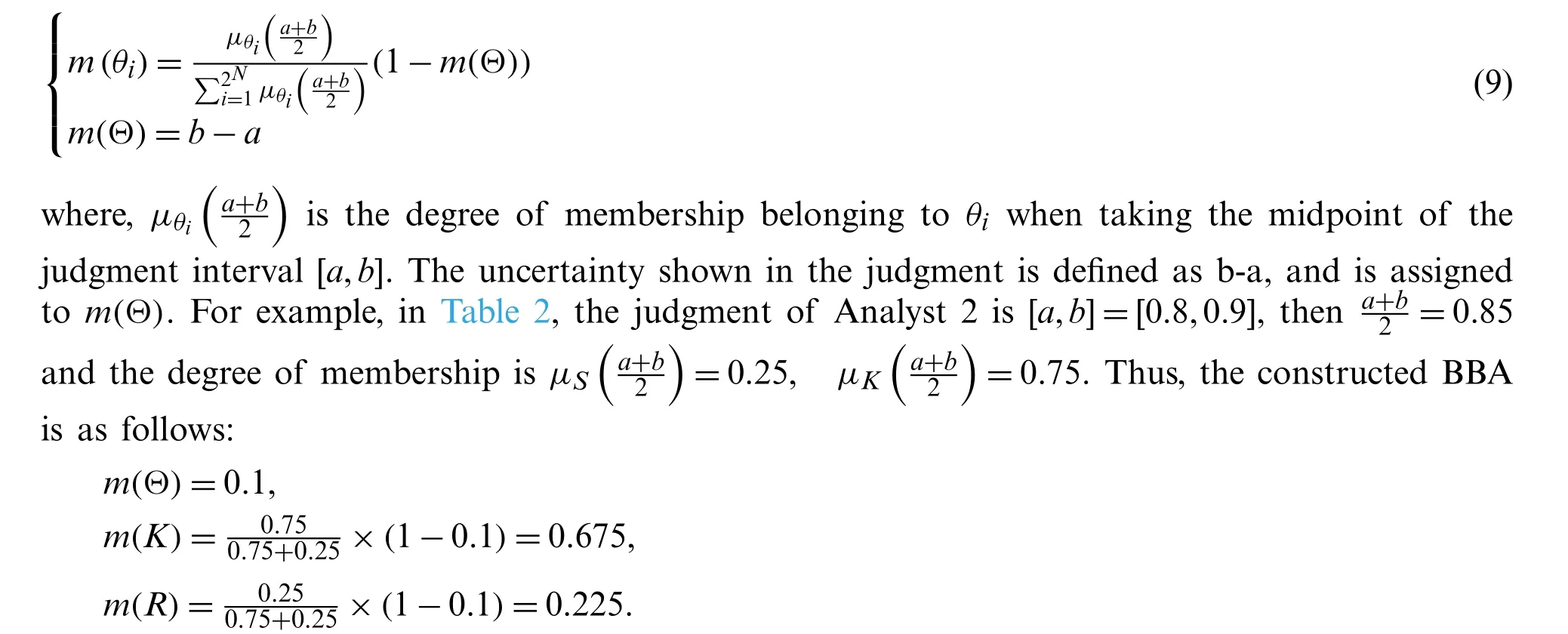
The BBAs of other analysts are shown in Table 3.

Table 3:BBAs of different analysts
Step 2.4:Discount BBAs based on analysts’confidence.In this step,the confidence level of the analyst in Step 2.2 is used to discount BBA through the evidence discount formula(see Eq.(5))to further express uncertain information,i.e.,the subjective uncertainty.For example,Table 2 shows that Analyst 2’s confidence in his/her judgment isα=0.8,and thus reconstructed BBA after discounting process is as follows:
αm(K)=αm(K)=0.675×0.8=0.54,
αm(R)=αm(R)=0.225×0.8=0.18,
αm(Θ)=1-α+αm(Θ)=0.28.
The BBAs of different analysts after discounting process are shown in Table 4.

Table 4:Discounted BBA
Step 2.5:Fusion of BBA.In order to comprehensively consider the judgment of each analyst,the Dempster’s combination rule(Eq.(6))was adopted to fuse the judgment of different analysts.The fused result is calculated as follows:
m(S)=0.101,m(R)=0.636,m(K)=0.174,m(Θ)=0.089.
Step 2.6:Probability transformation.After obtaining the fused BBA,the next problem is how to make decisions.The existing decision-making methods are mainly divided into two types:one is to make decisions directly according to the fusion results(fused BBA);the other is to convert fused BBA into a probabilistic form for decision-making.The second decision-making method is adopted in this step,that is,BBA is converted into a probabilistic distribution for decision-making.
In order to convert BBA into probability distribution,Eq.(8)was adopted to realize probability transformation.For the fused BBA obtained in the above process,the probability distribution obtained after transformation is as follows:

Step 2.7:Determine relevant parameters.Different from traditional HCR,this method does not directly determine the behavior type,but redetermines three parameters of Weibull distribution through the probability distribution obtained in the process of probability transformation.The parameter determination method in this step is as follows:

where,X=S,R,K.Cγ(X).Cη(X)andβ(X)are the normalized minimum reaction time,characteristic reaction time and shape parameters of three-level behaviors determined in traditional HCR experiment respectively.According to HCR parameter values in Table 1,parameters of the improved HCR model are selected as follows:
Cγ=0.593,Cη=0.614,β=0.92
4 Case Study
In the process of power plant operation,the reactor was shutdown automatically due to the loss of feedwater.In the case of failure of automatic reactor shutdown,according to the nuclear power plant operation procedures,the operator must achieve manual shutdown.The improved HCR model can be used to obtain the probability that the operator cannot complete manual shutdown within the allowed time.The process is shown in Fig.2.The following is the detailed process:
Step 1:Determine the allowable time;
According to the calculation,the operator must complete the task from the occurrence of the initiating event to the reactor shutdown within 79 s.According to the cognitive process of the operator,it can be divided into three stages,which are exploration,diagnosis and response.
1.Exploration:It is assumed that the information interface on the screen of the control room is unambiguous,the crew operators can easily find the indication signal of pump trip,and the reactor sends out an alarming signal for shutdown.If the automatic shutdown system fails,it will send out an automatic shutdown fault signal.The allowable time of exploration is specified as:T1=10s.
2.Diagnosis:According to the information indicated by the instrument,the operator can easily diagnose the occurrence of feedwater loss and automatic shutdown failure events.Regardless of the statistical possibility of incorrect diagnosis,the required diagnosis time isT2=15s.
3.Response:Considering that the nuclear power plant has a good ergonomic design,manual shutdown is not prone to negligence errors.Thus,the required response action time can be assumed to be ignored,that is,T3=0.The allowable timeTA=79s.
Step 2:Determine related parameters;
Step 2.1:Construct the judging panel;
The judging panel in this case is the same as shown in Fig.3.
Step 2.2:The analyst makes judgment and gives confidence;
The analyst’s input judgment and confidence are shown in Table 5.

Table 5:Different analysts’judgments and confidence in the case study
Step 2.3:The BBA is constructed from the judgment of different analysts;
In this step,the judgment of different analysts are converted into BBA,as shown in Table 6.

Table 6:BBAs of different analysts in the case study
Step 2.4:Discount BBAs based on analysts’confidence;
The BBAs discounted by Eq.(5)is shown in Table 7.

Table 7:Discounted BBA in the case study
Step 2.5:Fusion of BBA;
The fused result ism(S)=0.8538,m(R)=0.1395,m(Θ)=0.0068.
Step 2.6:Probability transformation;
The fused BBA is converted into a probability distribution:
BetPm(S)=0.8572,BetPm(R)=0.1428
Step 2.7:Determine relevant parameters;
The final parameter is determined as
Cγ=BetPm(S)·Cy(S)+BetPm(R)·Cγ(R)=0.686
Cη=BetPm(S)·Cη(S)+BetPm(R)·Cη(R)=0.435
β=BetPm(S)·β(S)+BetPm(R)·β(R)=1.16
Step 3:Determine the nominal performing time T1/2,nominal;
The nominal performing time can be obtained from the exploration,diagnosis,and response processes inStep 1,which is
T1/2,nominal =T1+T2+T3=25 s.
Step 4:Determine correction factor;
PSF parameter values of manual shutdown calculated by HCR model are shown in Table 8.According to the parameters,the actual median response time after PSF correction was obtained according to Eq.(1):

Table 8:Manual shutdown parameters
T1/2=25×(1+0)(1+0.28)(1+0)=32(s).
Step 5:Quantify error probability;
According to the non-response probability formula of Weibull distribution(Eq.(2)),the probability that the operator cannot respond to manual shutdown operation in the case of automatic shutdown failure of reactor can be calculated as

By comparing the traditional HCR with the improved HCR,it can be seen that the traditional HCR behavior classification relies on expert experience and existing subjectivity.In addition,the traditional HCR classifies cognitive behaviors into a single cognitive pattern(S,R,K).However,some behaviors are difficult when distinguishing the boundary between skill-based and rule-based(S-R),or the boundary between rule-based and knowledge-based(R-K).Thus,it is too rough to simply categorize them into one category.Also,various evaluations that were given by different analysts may provide some real conclusions on a certain behavior.These information should be used to gain a more reasonable result.The method proposed in this paper applies a calculation model to HCR,which can not only express uncertainty effectively but also reduce subjectivity.The analysts’judgments can be expressed in the forms of a precision value,an interval or a fuzzy number,and can indicate the confidence of the analysts.Subjectivity reduction benefits from the Dempster’s combination rule,which conforms to the agreements from different sources and reduces subjective uncertainty.Moreover,the probability distribution obtained using this model can be understood as the proportion of different types.It is more reasonable to comprehensively consider the three types of behavior to determine the final parameters.
5 Conclusion
In order to deal with subjectivity and uncertainty in the determination of cognitive behavior patterns in the traditional HCR methods,this paper proposes an uncertain information processing method based on D-S evidence theory on the basis of HCR.In the process,the analysts can give ambiguous judgments and demonstrate their confidence in the judgment so that they can effectively express the ambiguity and subjective uncertainty of the judgment.Dempster’s rule of combination applied in the process can reduce the subjective uncertainty of the analysts’judgments.The parameters of Weibull distribution in classical HCR model are redetermined based on linear combination of SRK types.This is quite simple.The relationship of the SRK types in determining parameters in HCR can be further investigated.
Funding Statement:The work is partially supported by Shanghai Natural Science Foundation(Grant No.19ZR1420700),sponsored by Shanghai Rising-Star Program(Grant No.21QA1403400),Shanghai Key Laboratory of Power Station Automation Technology(Grant No.13DZ2273800).
Conflicts of Interest:The authors declare that they have no conflicts of interest to report regarding the present study.
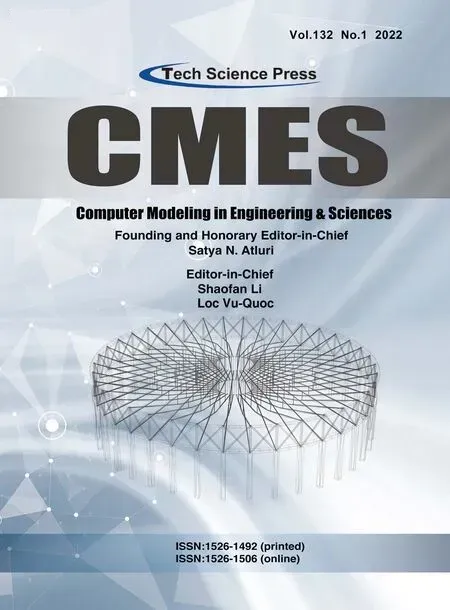 Computer Modeling In Engineering&Sciences2022年7期
Computer Modeling In Engineering&Sciences2022年7期
- Computer Modeling In Engineering&Sciences的其它文章
- Discrete Element Simulations of Ice Load and Mooring Force on Moored Structure in Level Ice
- Investigation of the Free Vibrations of Radial Functionally Graded Circular Cylindrical Beams Based on Differential Quadrature Method
- Performance Evaluation of Electromagnetic Shield Constructed from Open-Cell Metal Foam Based on Sphere Functions
- A Fast Element-Free Galerkin Method for 3D Elasticity Problems
- Edge Detection of COVID-19 CT Image Based on GF_SSR,Improved Multiscale Morphology,and Adaptive Threshold
- An Optimized Convolutional Neural Network with Combination Blocks for Chinese Sign Language Identification
